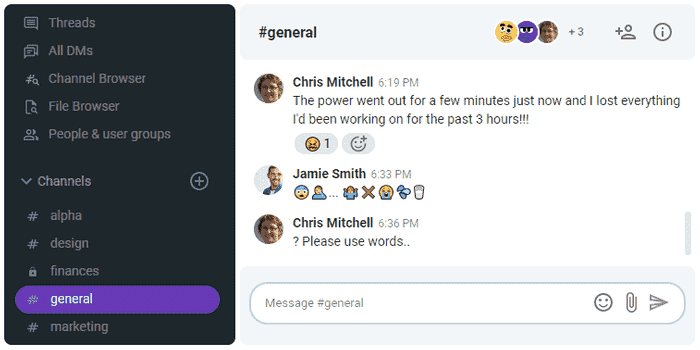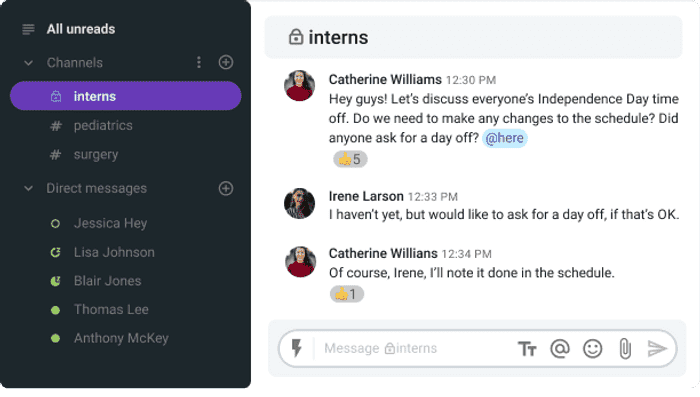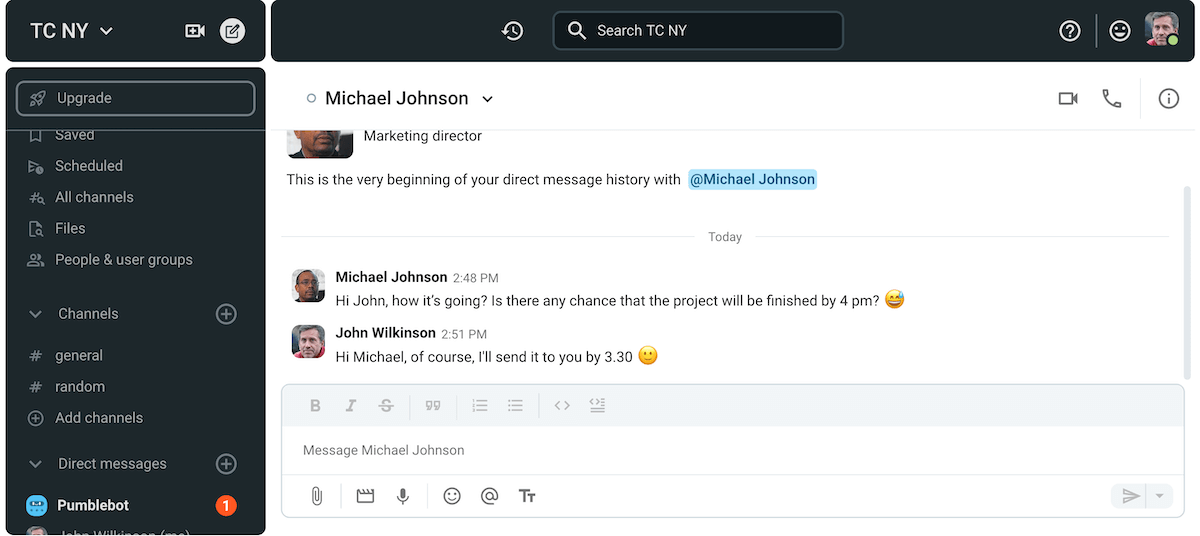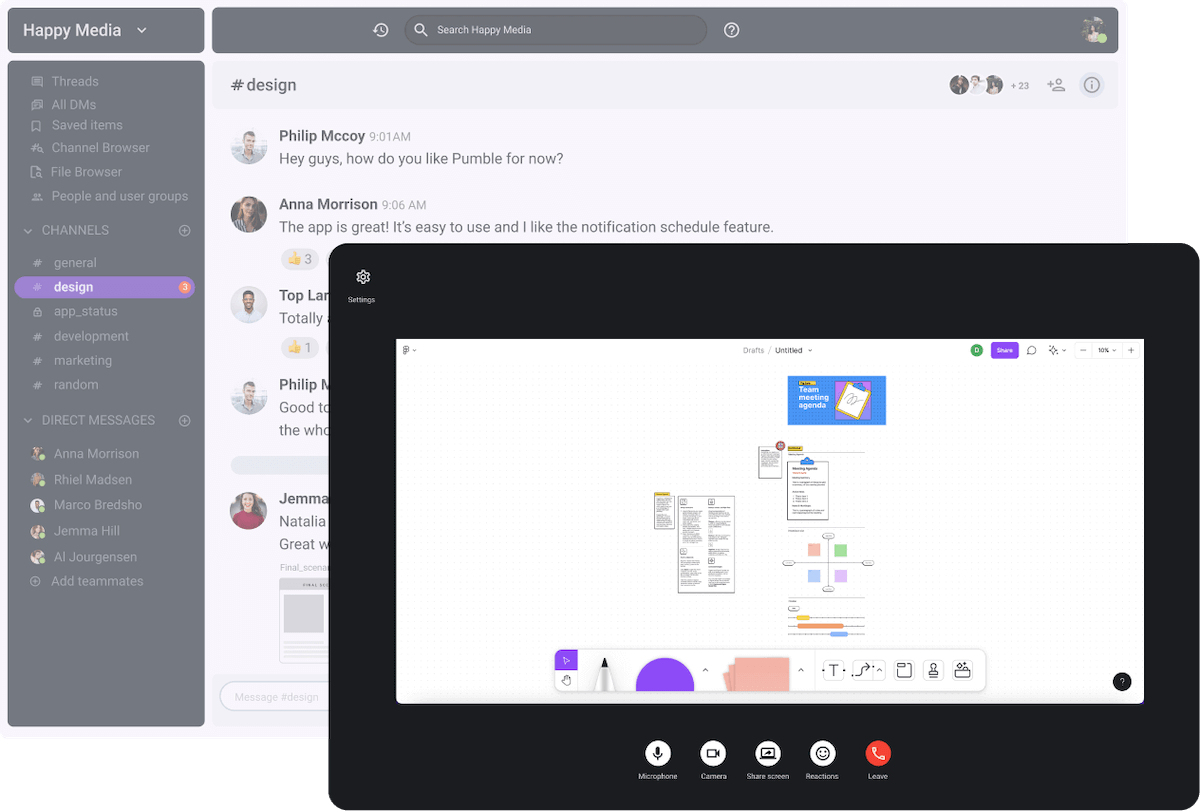Antoine de Saint-Exupéry once said: “Words are the source of misunderstandings.” Still, apart from being the source of misunderstanding, words are also a means of communication – the foundation of any successful relationship, including professional ones.
Namely, effective communication is essential for a productive workplace. According to Workplace communication statistics 2021, when teams communicate effectively, their productivity may increase by 25%.
On the other hand, another research shows that over 70% of surveyed 2,000 office workers experienced some form of unclear communication from their coworkers. So, why is it so easy to get lost in (mis)communication? And is there a way to avoid miscommunication in the workplace?
Don’t worry, all’s not lost. In the following paragraphs, we will deal with miscommunication in the workplace. First, we’ll see what it actually means. Then, we’ll consider the most common causes for miscommunication in the workplace. Finally, we’ll give you some examples of miscommunication, as well as some advice for solving this problem.

Table of Contents
What is miscommunication in the workplace?
Miscommunication in the workplace occurs when coworkers don’t communicate effectively, so they don’t understand the intent and meaning of the message conveyed to them. Unfortunately, this can potentially lead to internal conflict and employee dissatisfaction.
Miscommunication happens more often than you probably think.
Namely, according to the report The State of Miscommunication, a whopping 81% of employees say workplace miscommunication occurs very frequently, frequently, or occasionally.
What’s even more interesting is the fact that 50% of employees say that they’ve never, seldom, or rarely directly been involved in workplace miscommunication.
Talk about the “It’s not me, it’s you” situation.
Now, you may think: “What’s the big deal? Everything gets sorted out in the end, right?” Yes, probably — but it comes with a price tag.
What is the cost of miscommunication in the workplace?
The effects of miscommunication are real and not to be sneezed at. So, let’s see what the price tag on miscommunication in the workplace is.
In their study, Communication Barriers in the Modern Workplace, The Economist Intelligence Unit shows us that 44% of respondents said that miscommunication has delayed project completion or has brought about failure.
Additionally, 18% of the respondents indicated that miscommunication was the cause of the loss of a sale. Almost a third of these sales were valued between US$100,000 and US$999,999.
Furthermore, in her report, Top Ten Email Blunders that Cost Companies Money, Debra Hamilton states that a company with 100 employees is expected to lose almost half a million dollars a year due to misunderstandings and email blunders.
How’s that for a price tag?
Aside from the material side of the costs, there is a toll miscommunication takes on the health of the employees.
The same study states that 52% of the respondents highlighted stress, and 31% of them cited low morale as a consequence of miscommunication in the workplace.
Now that we know the true cost of miscommunication in the workplace, let’s see what the main causes of miscommunication are.
What causes miscommunication in the workplace?
As mentioned above, 50% of respondents in the study about miscommunication in the workplace don’t believe they are to blame when it comes to such situations.
Is it really possible?
The fact is people tend to believe it’s not their fault because of the defense mechanism called self-serving bias.
Namely, people usually take responsibility for success — but blame others for failures.
Even if we are to blame in only 50% of situations, there has to be a logical explanation for all our misunderstandings. Right?
But, let’s look at some of the real causes of miscommunication in the workplace.
Different communication styles across generations
One of the most common causes for miscommunication in the workplace is the difference in communication styles. Since modern companies are usually multigenerational environments, this is especially evident across generational divides.
Aside from preferring different communication channels, different generations simply communicate differently.
For instance, digital natives – Millennials and Gen Z – are known to use emojis, even in professional settings, whereas other generations refrain from using them.
This can sometimes lead to misunderstandings among these generations — which consequently has negative effects on business.

Poor leadership
Another common cause of miscommunication in the workplace is poor leadership.
Since effective downward communication starts from the managers, their job is to motivate their staff to be more productive and creative.
However, poor leadership can leave employees feeling confused and unmotivated.
If there is a lack of downward communication, the objectives of the company may be unclear to the employees, which can demoralize them.
Limited feedback is another problem, which leads to employees making assumptions that are often not true.
💡If you want to find out more about constructive feedback when working remotely, check out our blog post about it.
Lack of awareness about cultural diversity in the workplace
Since ever more companies are conducting business globally, or have team members from all around the world, awareness about cultural diversity in the workplace is becoming even more relevant than before.
Among other things, different cultures imply different holidays, which can lead to various misunderstandings, as shown in the example below.

Confusing body language
How many times have you heard the following remark: “It’s not just what you said, but how you said it”?
You have also probably heard that 90% of communication is nonverbal. There’s even a hotly debated and often disputed formula, 55/38/7, which claims that communication is 55% nonverbal, 38% vocal, and 7% words only. Actually, this formula is a misrepresentation of findings that Albert Mehrabian, a professor of psychology, presented in his study. The actual formula goes like this:
Total liking = 7% verbal liking + 38% tonal liking + 55% facial liking
The truth is, nonverbal and verbal communication are interconnected, and our body language colors our words.
Still, what does it mean for our digitalized world, where more and more communication takes place in the virtual world? How do we take into account digital body communication?
Try to remember your last work email. Did you follow the punctuation rules or abolish them completely? Did you use emojis? Have you made any typos?
What about your last video meeting? How many times did you check your phone or something on your computer while your colleagues were talking?
These are all examples of digital body language, according to Erica Dhawan.
In her book Digital Body Language: How to Build Trust and Connection, No Matter the Distance, she writes that “reading carefully is the new listening, writing clearly is the new empathy, and a phone call is worth a thousand emails.”
Just like in our analog lives, we need to mind our body language in our digital lives, as well — if we want to avoid misunderstandings.
Undercommunication
Another cause of miscommunication in the workplace is undercommunication.
Undercommunication is unclear, inconclusive, and vague communication among coworkers.
Not having enough information about a project, or any other vital component of business life leads employees to assume what is going on.
That’s how rumors are born.
Aside from that, sometimes undercommunication results in misunderstandings that could easily have been avoided.
For instance, many remote teams work in multiple time zones.
That’s why it’s important to explicitly state when a certain meeting will take place. Is it at 9 a.m. CST or EST? These kinds of mix-ups are avoidable if you only pay more attention to communication in the workplace.
–
Now that we’ve seen what are the usual causes for miscommunication in the workplace, let’s illustrate them with some examples.
Examples of miscommunication in the workplace
What 50% of employees do you belong to? Can you take the blame for miscommunication in your workplace? Or do you believe that it’s exclusively your colleagues’ fault when a message veers off course into a rabbit hole of misunderstanding?
Let’s look at a few short tales of miscommunication in the workplace to make the matter clearer.
Workplace miscommunication example #1: Effort not recognized
Let’s say you have been working on a really big project with your team for months. You’re really pulling your weight — but somehow, all your hard work goes unnoticed. On the other hand, your colleagues are being praised every step of the way. This leaves you perplexed and with the need to reexamine your place in your team and the company.
🔸 What is said: “I do all the work and my colleagues get the credit.”
🔸 What is meant: “I’ve noticed that my colleagues are being recognized, but I’m left out. Is there any reason for that? Am I doing something wrong? Some feedback would be nice.”
🔸 How to make the message clearer? “I’d like to be acknowledged, and would like to get some feedback.”
🔸 How the other person should respond: The manager should take a step back and analyze the situation. They should consider whether they really are overlooking your contribution to the team’s success. If so, it would be nice to show their appreciation for your hard work.
Workplace miscommunication example #2: Feeling undervalued
Picture this situation: Anna has been working in the same company for 10 years. It is her dream job and she’s really putting herself out there and doing an amazing job. Still, her managers are so used to the fact that she’ll always do her tasks on time and exquisitely, that they don’t make an effort to reward her in any way.
🔸 What is said: “I’m working way too much for the amount I’m paid.”
🔸 What is meant: “I feel undervalued and unappreciated. All my hard work amounts to nothing and I’m feeling overworked.”
🔸 How to make the message clearer? “I think I’m giving my best and would like to be compensated accordingly.”
Or: “I’d like to discuss my workload. Maybe we should delegate some of my tasks to others.”
🔸 How the other person should respond: Anna’s manager should take a good look at Anna’s role in the company. If the manager doesn’t want to lose a valuable employee such as Anna, they should reconsider why she is dissatisfied. According to research, 79% of employees who quit their job say the main reason for their leaving is lack of appreciation. Managers should give their best to make employees feel appreciated. On the other hand, if Anna is truly overworked, maybe the problem is a company culture that encourages employees to work overtime. If that’s the case, they’re risking their workers’ health, because overwork can quickly lead to burnout.
Workplace miscommunication example #3: Feeling unmotivated
Consider this scenario: Greta is practically a wunderkind. Right after finishing her master’s degree, she got a job as a graphic designer in a well-known company. However, three years have passed since, and she’s still getting tedious entry-level tasks.
🔸 What is said: “I’m bored at my job.”
🔸 What is meant: “I need more responsibility.”
🔸 How to make the message clearer? “I think I could contribute more to this company. Would you consider giving me more demanding tasks?”
🔸 How the other person should respond: This is maybe the easiest challenge for the manager to conquer. An employee of yours wants more responsibility? Good! Try to include Greta in cross-functional teams or give her a side project. Talk to her about the next steps she needs to take in order to advance in her career. When you show your employees there is room for growth, they will certainly be more motivated and engaged.
Workplace miscommunication example #4: Feeling purposeless
Imagine this situation: Every single day, Mia goes to the same office, doing the same old job as a secretary of a big company. Every single day, she drinks coffee with the same colleagues at the same spot (next to the window so she can look at the nearby park). Every day is the same as the one before. A Groundhog’s day, if she ever saw one!
🔸 What is said: “All this work is going nowhere.”
🔸 What is meant: “I need vision.”
🔸 How to make the message clearer? “I’d like to know more about company goals and plans, so I could do my job better.”
🔸 How the other person should respond: A leader must inspire as well as lead. Their job is to give purpose and vision to their employees. When employees have a clear vision of their company, their own role in the process is clearer and that is a great incentive. According to Net Impact’s Talent Report, as much as 65% of workers and students (future workers) claimed that “the potential to contribute to society” and “a job that will make the world a better place” is really important to them. Mia would certainly feel more engaged if her managers would inspire her and give her work purpose.
Workplace miscommunication example #5: Fear of delegating tasks
Think about this for a moment: Diego is great at his job as a manager of a retail store. He supervises ten employees in the store in a large shopping mall. However, his habit is to micromanage his team and even do their tasks, if he deems it necessary.
🔸 What is said: “It’s easier to do everything myself.”
🔸 What is meant: “I’m scared to delegate.”
🔸 How to make the message clearer? “Sometimes it’s hard for me to delegate tasks to others, but I’m working on it. I’ll try to delegate more.”
🔸 How the other person should respond: Diego isn’t the only manager who has a problem with delegation. Actually, we might call this problem of his a fear of delegation. However, to avoid micromanagement, managers should delegate their tasks and have faith in their subordinates. Although sometimes used to avoid responsibility and blame, delegation is a useful tool for better productivity. This way, time is used more effectively, and it’s easier to achieve set goals.
–
Now that we’ve looked at some examples of miscommunication in the workplace, let’s see how we can solve this problem, and banish it from our work environment.
7 Tips on how to solve miscommunication in the workplace
If you think you’re doomed to make mistakes that stem from miscommunication, cheer up! There are some ways to avoid miscommunication altogether. We promise you, it’s easier than you think, and it’s not anything new. We all know how to do this.
So let’s dig in!
1️⃣ Never assume anything – overcommunicate instead
First of all, never assume anything.
It’s better to overcommunicate than to think we have understood everything our colleague had told us.
The trouble with assuming what other people think is the fact that we all have a different horizon of understanding, that is “the range of vision that includes everything that can be seen from a particular vantage point”.
This horizon depends on our previous experiences and helps us interpret new situations.
Since we don’t all share the same horizon of understanding, we can easily come to the wrong conclusions in conversations with our coworkers.
That’s why it’s crucial to overcommunicate with our colleagues, as well as put ourselves in their shoes.
Only then can we hope to grasp the true meaning of our colleagues’ words.
2️⃣ Pay attention to nonverbal communication (even online)
When conversing with our colleagues in physical space, it’s easier to take into account their body language. And we should do that if we want to avoid miscommunication. On the other hand, to avoid miscommunication in an online world, digital body language should not be neglected.
In our search for ways to rid our workplace of miscommunication, we reached Allie Gallinger, a speech-language pathologist.
She gave us advice, based on her work experience:
“I work with my clients on the concept of nonverbal communication being lost over a screen. If companies are using instant messaging and email as their primary method of communication, there is likely a lot of nonverbal communication being missed. To be more specific, one cannot see another person’s facial expression and body language and cannot hear a person’s tone of voice. For example, if you send or receive a message that simply says, ‘thanks,’ without nonverbal communication, this can be interpreted as someone being angry. One way to solve this difficulty is to be explicit over instant messaging and email. Say what you mean, mean what you say, and use punctuation to make things very clear. Also, where possible, speak in person! It is much harder to have miscommunications when you can see and hear a person.”
3️⃣ Double-check your messages and emails to avoid (costly) mistakes
This tip naturally follows the previous one.
Namely, to avoid mistakes (and consequently, misunderstandings), you should always double-check your messages and emails. Sometimes dubbed “emotional amplifiers”, typos are to be avoided in business communication. Aside from making you look less competent and professional, they can sometimes lead to serious misunderstandings and can have dire consequences.
Do you think we’re exaggerating?
Let us tell you a story of a letter S worth 8.8 million pounds.
Once upon a time (actually, in 2009), a British government agency stated that a 124-year-old engineering firm named Taylor & Sons Ltd. had gone into liquidation. Almost immediately, Taylor & Sons’ orders were canceled, and their contracts were lost. A few years later, the company went bankrupt.
So, what’s the problem?
Where’s the human error if the company actually went bankrupt?
Was the agency clairvoyant?
No, they didn’t have a crystal ball.
The problem was the letter S and a simple typo. Namely, a government agency had meant to report that Taylor & Son Ltd. went bankrupt, not Taylor & Sons Ltd. Although the company corrected its mistakes a few days later, the damage was already done. Naturally, Taylor & Sons Ltd. sued the company, won 8.8 million pounds, and lived happily ever after — FYI, the company is still active.
4️⃣ Practice active listening
In her Ted talk, Katherine Hampsten highlights the importance of active listening in an effort to avoid miscommunication. Here are her tips:
- Passive hearing and active listening are not the same thing 🦻
We should adjust our message to the listener (or reader), to achieve better understanding.
- Listen with your eyes, ears, and guts 👀👂🖤
Don’t forget, communication is more than words.
- Take time to understand as you try to be understood ⏰
We easily forget that communication is a two-way street.
- Be aware of your own perceptual filters 🕶
Your background, culture, community, and family influence how you see the world. Keep in mind that your perception is not necessarily objective truth.
If you stick to Hampsten’s advice, you should be able to avoid the majority of misunderstandings.
5️⃣ Discuss expectations
One of the ways to avoid miscommunication is to openly discuss expectations with your coworkers. Before you start a new project, you should make sure everyone is clear on the goals, so they can adjust their expectations.
Changes are usually stressful, but there is a right way of communicating them. Only when you listen to all the questions from your coworkers and patiently answer them, can you be sure that you’ve successfully avoided any misunderstandings.
6️⃣ Be aware of cultural differences
When working in multicultural environments (virtual or not), we should take into consideration other cultures and make an effort to get familiar with their customs, traditions, and communication strategies.
That is why effective cross-cultural communication is key to a better atmosphere in the workplace and a safe road to avoiding miscommunication.
7️⃣ Take responsibility
Last but not least, take responsibility for your mistakes.
We all make them, whether we want to admit that or not.
After all, as Alexander Pope once said, “to err is human, to forgive, divine”.
We’ve already learned that only 50% of us take responsibility for cases of miscommunication. Maybe if we all would think hard about our role in these situations, there would be fewer misunderstandings.
From the narrative “It’s not me, it’s you”, maybe we should switch to “It’s not you, it’s me”, no matter how phony (thanks to pop culture) that sounded.
Maybe we should aspire to the second part of Alexander Pope’s saying – and encourage coworkers (as well as ourselves) to admit their fault and be forgiven. Perhaps that is the way to a flawless workplace.
Pumble helps you avoid miscommunication in the workplace
As stated above, overcommunication is necessary if you want to avoid misunderstandings.
Hence, it is important to have various communication options at your disposal and thanks to Pumble, you do.
First, you can always direct message your colleague or post in channels and ask for clarification or provide one.

If you have additional questions, you can use threads or schedule a video or voice call.
During video calls, you can share your screen with other participants and reduce the chances of potential miscommunication.

Pumble also lets you share files to further document your conversations and avoid any potential miscommunication in the workplace.
Finally, if you want to jog someone’s memory about any particular topic but don’t want to disturb them during off hours, you can set reminders and do so during their work hours.




